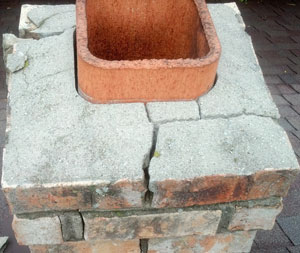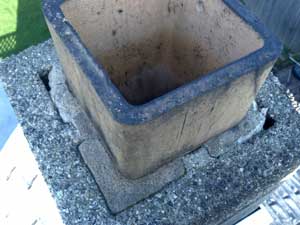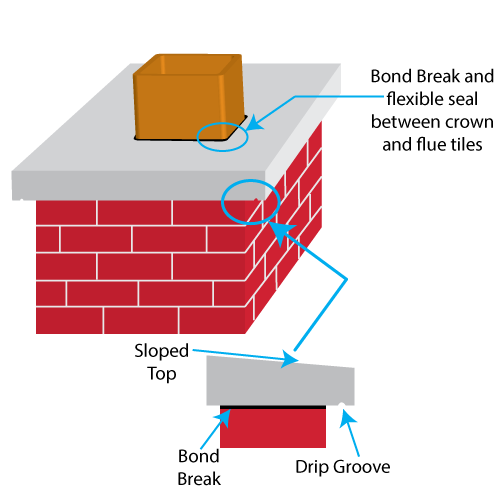Cracked or Deteriorated Chimney Crowns/Caps Cause Leaks
Disclaimer:
These problems are meant to be examples of the common ways chimneys can leak from my past experiences. Any of these examples or none of these examples may apply to your chimney. Always contact a licensed chimney expert for your particular chimney leaking problems.

The chimney crown or "cap" as it is commonly referred to, is the mortar or concrete on top of the brick or stone that you see. if the crown or cap is cracked it will allow water to seep in behind the brick work.
If the cap or crown is made from mortar, it can be even worse. Mortar does not repel water by default, instead it can absorb water, which again will leak into the chimney structure. The water that is in the chimney structure is subject to gravity. Water works its way down through the masonry and can eventually work its way into the house. Water that is trapped in the chimney will often degrade the chimney structure especially in a northern climate such as Wisconsin.

Lack of a concrete cap has hurt this chimney's structure.
With the extreme temperature changes that we experience in Wisconsin, the water that is trapped in the masonry with freeze and thaw. As water freezes it expands, it is this action that causes more damage to the brick and mortar. Damaged brick and mortar will often eventually lead to more water getting in.
Typically a crown should be poured from concrete at least a few inches thick. The top of the crown should slope away from the flue tiles, so water runs off. Many of the crowns today have expansion joints between the flue tile and the concrete to provide for expansion. The "expansion joint" should be sealed with a flexible durable sealant to keep the water out of the chimney.
Solution for a Bad or Cracked Chimney Crown or Cap:
Have a qualified company or persons form and pour a new concrete cap. One of the most common types of poured concrete cap is diagrammed below:

The concrete chimney crown is recommended to be poured from concrete, NOT MORTAR. There should be proper bond breaks and sealants to prevent water intrusion. The top should slope away from the center of the crown so water can run off the top of the chimney. Sometimes the crown overhangs with a drip ledge so water is prevented from running back towards the chimney.
Fixing the existing chimney cap/crown:
If the crown or cap is still structurally stable and viable, an elastomeric compound such as Saver Systems Crown Seal may be used to provide a moisture barrier to the existing chimney crown/cap.
